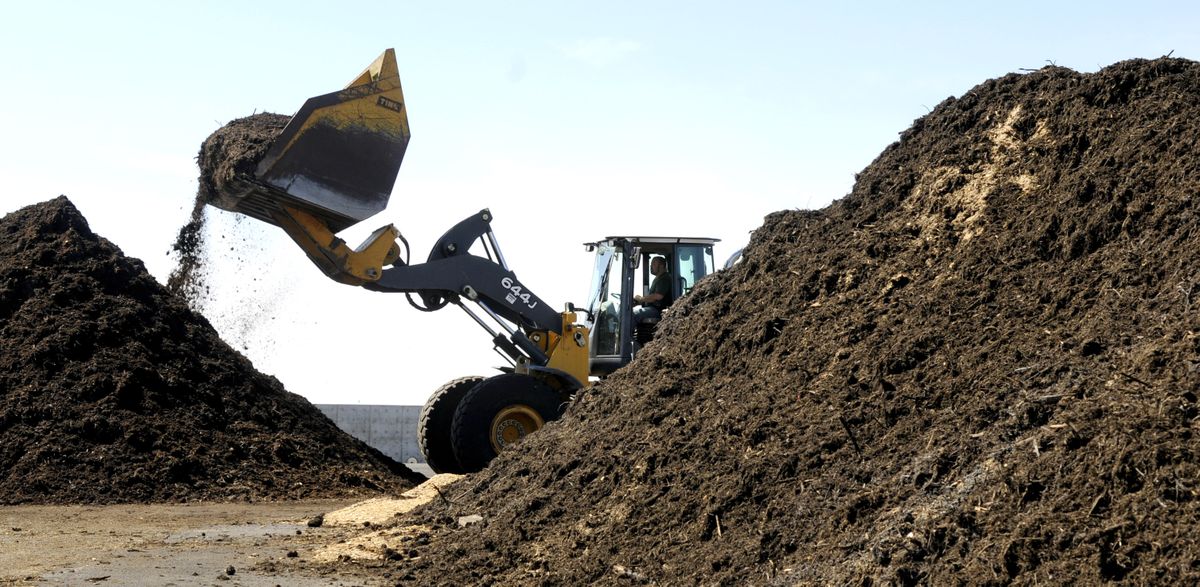Volunteers deliver 12,000 pounds of fish to composting operation
Rotting carp were from Long Lake die-off

The big stink over a fish die-off in Long Lake has neutralized into the sweet smell of a new green business in Lincoln County.
More than 12,000 pounds of rotting carp were delivered last week to the Barr-Tech composting operation near Interstate 90 about 22 miles southwest of Spokane.
“We just barely cut the ribbon on our brand-new facility and here comes a big load of fish, something we wouldn’t normally expect,” said Larry Condon, general manager of the $9 million operation.
The company, which is bidding on contracts for materials such as food and yard waste from companies like Waste Management Inc., just tipped its first paying load on Tuesday.
But last week, the company offered to take a load off the minds and noses of Long Lake residents.
“It would be a complete waste for them to pay a landfill to take the fish,” Condon said. “We’re brand new and we want people to know we’re here to convert waste into beneficial uses.”
Barr-Tech was one of several groups offering to deal with thousands of carp and some suckers that went belly up. State environmental officials pegged the kill on a sudden water temperature change while the fish were spawning in shallow water along the 24-mile-long reservoir behind Long Lake Dam.
Samples of the fish are still being tested in labs, said Chris Donley, Washington Fish and Wildlife Department fisheries biologist. “It’s not abnormal to see some fish die after spawning and disappear, but this was an unusually big event that involved a lot of big carp you couldn’t overlook.”
Larry Guenther, Stevens County commissioner, praised the lake residents who stepped up and responded to the stench.
“The county helped put people in touch with folks willing to take the fish,” he said, noting that volunteers, a barge crew and Avista did most of the work.
Scott Chaney, a lakeshore resident, helped send e-mails and organize the cleanup. Some of the carcasses were infested with maggots, he noted.
“You cannot imagine the stink,” Chaney said. “I’ve done some dirty jobs in my day, but I’ve never done anything even remotely this disgusting.”
Avista donated $2,000 to the effort. The money was used to pay some of Barr-Tech’s transportation costs and for 14 hours of cleanup by a crew working for Ron Costa, a lake resident and boat builder who owns a small barge.
“After completing our 14 hours, we dumped our fish in a Barr-Tech bin, but people were waving us over to their places as we motored back up the lake.
“We worked another four hours beyond our contract on the way back,” he said, noting the extra fish were buried by a friend who had 20 acres and a backhoe.
The 12,000 pounds of fish delivered to Barr-Tech was just a fraction of the dead fish concentrated in the reservoir’s lily pad patches, Costa said. “We needed three more days to do the job.”
But nature is gradually resolving the issue.
“You still see fish, but it’s far, far better now,” Chaney said Wednesday.
And Barr-Tech is coming out of this smelling like a rose. The company, just getting started after three years of design and construction, provided the big bins for collecting the carcasses and accepted three huge truckloads of fish.
“We ran them through a shredder mixed with grass and sawdust, which was fairly disgusting, as you can imagine,” Condon said. “Then we mixed in more material and buried it through the center of our compost pile and covered it with tarps.
“The next day, you couldn’t smell it at all. That was a real eye-opener for what we can do,” he said, noting that he’d taken a class on composting fish from the Organic Recycling Council.
The resulting compost should be a good product rich in nitrogen, he said, but it won’t necessarily be marketed as carp compost.
“That 6 tons of fish is just a fraction of the 230,000 tons of material we can handle a year,” he said.
Barr-Tech has eight employees, with plans to grow to 35 or 40 as work is under way for the company’s $5 million waste-to-energy digester.
The digester will be capable of producing three megawatts of electricity that’s already contracted to Inland Power and Light, Condon said.
Funded by a mix of private money and federal and state grants, the facilities soon could be converting municipal, commercial and farm waste into fertilizer, enough electricity to supply 1,000 homes and substitutes for some of the chemical industry’s petroleum-based raw material.
“Nothing will be wasted,” Condon said. “Not even the carp.”